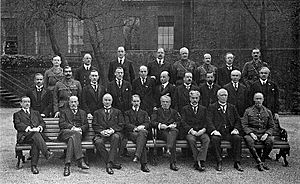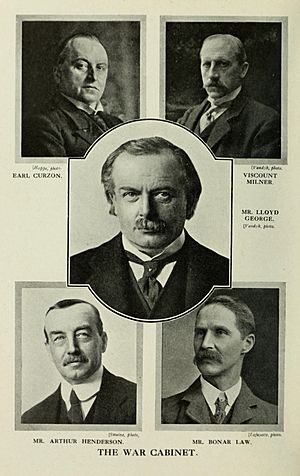Lloyd George ministry facts for kids
Quick facts for kids Lloyd George ministries |
|
|---|---|
|
|

Lloyd George’s Imperial War Cabinet in 1918
|
|
| Date formed |
|
| Date dissolved |
|
| People and organisations | |
| Monarch | George V |
| Prime Minister | David Lloyd George |
| Prime Minister's history | 1916–1922 |
| Total no. of members | 269 appointments |
| Member parties |
|
| Status in legislature | Majority (coalition) |
| Opposition party | Independent Liberal Party |
| Opposition leaders |
|
| History | |
| Election(s) | 1918 general election |
| Legislature term(s) |
|
| Outgoing formation | Carlton Club meeting |
| Predecessor | Asquith coalition ministry |
| Successor | Law ministry |
In December 1916, David Lloyd George became the Prime Minister of the United Kingdom. He was chosen by King George V. Lloyd George, a member of the Liberal Party, formed a special government. This was a coalition government, meaning it included politicians from different parties.
This new government took over during the Great War. It replaced the previous government, which many people blamed for problems in the war. Some Liberals did not support Lloyd George. They became the Official Opposition, which means they were the main group against the government.
Lloyd George's government stayed in power even after the war ended in 1918. However, he started to rely more on the Conservative Party. Eventually, after some disagreements and concerns about how certain awards were given out, the Conservatives decided to stop supporting him. This happened after a special meeting at the Carlton Club in 1922. After this, Bonar Law formed a new government.
Contents
Lloyd George's Cabinets: Leading the Country
A cabinet is a group of important government ministers. They help the Prime Minister make big decisions. Lloyd George had two main cabinets during his time as Prime Minister.
The War Cabinet (1916–1919)
This first cabinet was formed during World War I. It was a small group of very powerful people. Their main job was to focus on winning the war.
Here are some of the key members when it started:
- Lord Curzon of Kedleston – He was in charge of the Privy Council and led discussions in the House of Lords.
- Bonar Law – He managed the country's money as Chancellor of the Exchequer and led the House of Commons.
- Arthur Henderson – He was a minister without a specific department.
- Lord Milner – He also served as a minister without a specific department.
Changes in the War Cabinet
The War Cabinet changed a few times as the war continued:
- In May 1917, George Barnes temporarily joined the cabinet. He was the Minister of Pensions.
- In June 1917, Jan Smuts became a minister without a specific job.
- In July 1917, Sir Edward Carson also joined as a minister without a specific job.
- In August 1917, George Barnes officially replaced Arthur Henderson.
- In January 1918, Carson left the cabinet.
- In April 1918, Austen Chamberlain took over from Lord Milner.
- In January 1919, Bonar Law changed roles. He became Lord Privy Seal but stayed as Leader of the House of Commons. Austen Chamberlain became the new Chancellor of the Exchequer. Sir Eric Geddes replaced Jan Smuts.
The Peacetime Cabinet (1919–1922)

After the war ended, the government shifted its focus. In January 1919, a larger cabinet was formed to deal with peacetime issues.
Here are some of the important people in this cabinet:
- David Lloyd George – Still the Prime Minister.
- Lord Birkenhead – The Lord Chancellor, a top legal official.
- Lord Curzon of Kedleston – He was still Lord President of the Council and Leader of the House of Lords.
- Bonar Law – He became Lord Privy Seal and Leader of the House of Commons.
- Austen Chamberlain – He was the Chancellor of the Exchequer, managing the country's money.
- Arthur Balfour – He was the Foreign Secretary, dealing with other countries.
- Winston Churchill – He was the Secretary of State for War and Air.
Changes in the Peacetime Cabinet
This cabinet also saw many changes over time:
- In May 1919, Sir Auckland Geddes took over as President of the Board of Trade. Sir Eric Geddes became Minister of Transport.
- In October 1919, Lord Curzon became Foreign Secretary. Arthur Balfour became Lord President. New ministries were created, like the Ministry of Health with Christopher Addison as Minister.
- In January 1920, George Barnes left the cabinet.
- In March 1920, Sir Robert Horne became President of the Board of Trade.
- In April 1920, Sir Hamar Greenwood became Chief Secretary for Ireland.
- In February 1921, Winston Churchill became Colonial Secretary. Sir Laming Worthington-Evans became War Secretary.
- In March 1921, Austen Chamberlain became Lord Privy Seal and Leader of the Commons. Sir Robert Horne became Chancellor of the Exchequer. Stanley Baldwin became President of the Board of Trade.
- In April 1921, Christopher Addison became a Minister without Portfolio. Sir Alfred Mond became Minister of Health.
- In November 1921, Sir Eric Geddes left the cabinet. The Attorney General, Sir Gordon Hewart, joined the cabinet.
- In March 1922, Lord Peel became India Secretary.
- In April 1922, Lord Crawford, who was First Commissioner of Works, joined the cabinet.
Images for kids



